tire type JEEP LIBERTY 2005 KJ / 1.G Owners Manual
[x] Cancel search | Manufacturer: JEEP, Model Year: 2005, Model line: LIBERTY, Model: JEEP LIBERTY 2005 KJ / 1.GPages: 424, PDF Size: 11.56 MB
Page 238 of 424
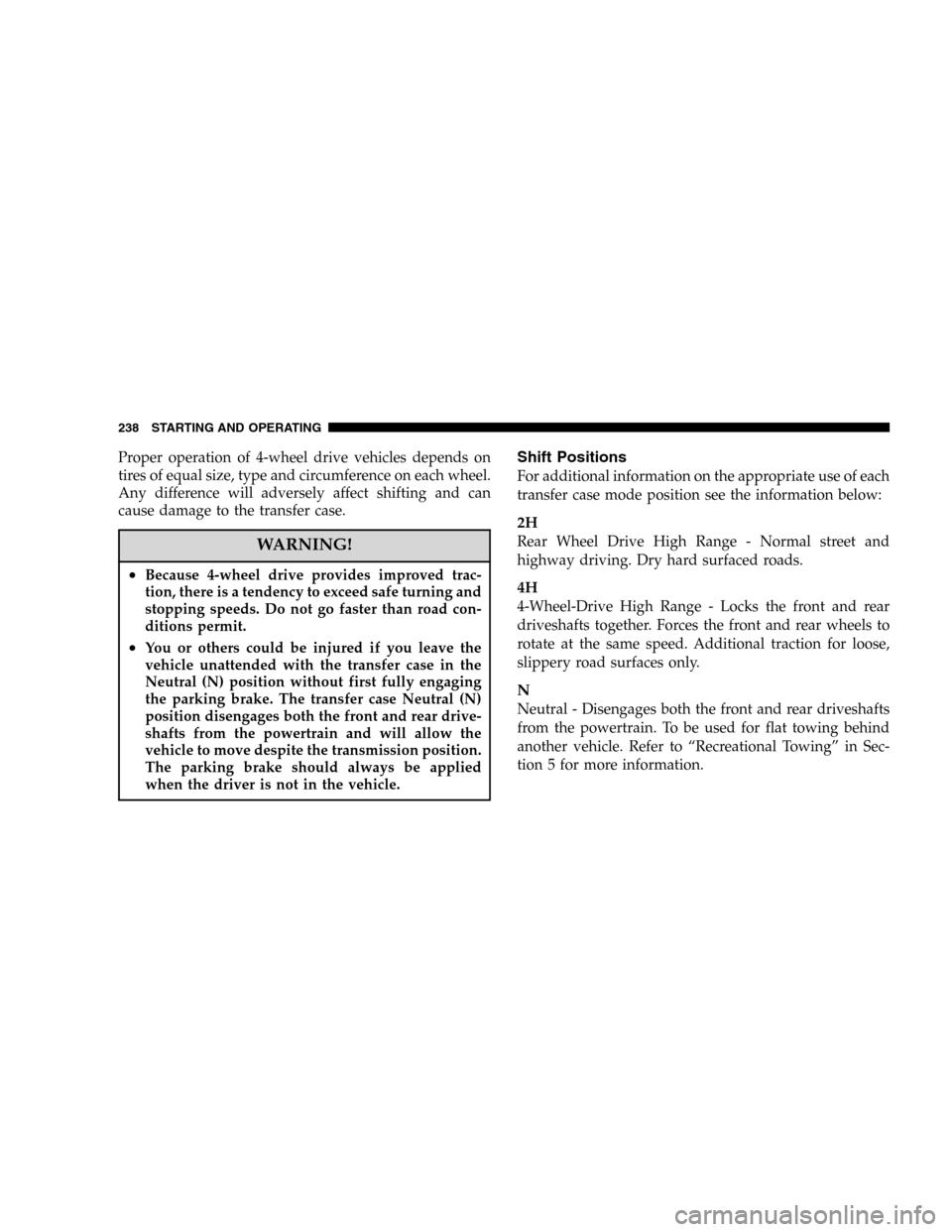
Proper operation of 4-wheel drive vehicles depends on
tires of equal size, type and circumference on each wheel.
Any difference will adversely affect shifting and can
cause damage to the transfer case.
WARNING!
•Because 4-wheel drive provides improved trac-
tion, there is a tendency to exceed safe turning and
stopping speeds. Do not go faster than road con-
ditions permit.
•You or others could be injured if you leave the
vehicle unattended with the transfer case in the
Neutral (N) position without first fully engaging
the parking brake. The transfer case Neutral (N)
position disengages both the front and rear drive-
shafts from the powertrain and will allow the
vehicle to move despite the transmission position.
The parking brake should always be applied
when the driver is not in the vehicle.
Shift Positions
For additional information on the appropriate use of each
transfer case mode position see the information below:
2H
Rear Wheel Drive High Range - Normal street and
highway driving. Dry hard surfaced roads.
4H
4-Wheel-Drive High Range - Locks the front and rear
driveshafts together. Forces the front and rear wheels to
rotate at the same speed. Additional traction for loose,
slippery road surfaces only.
N
Neutral - Disengages both the front and rear driveshafts
from the powertrain. To be used for flat towing behind
another vehicle. Refer to “Recreational Towing” in Sec-
tion 5 for more information.
238 STARTING AND OPERATING
Page 242 of 424
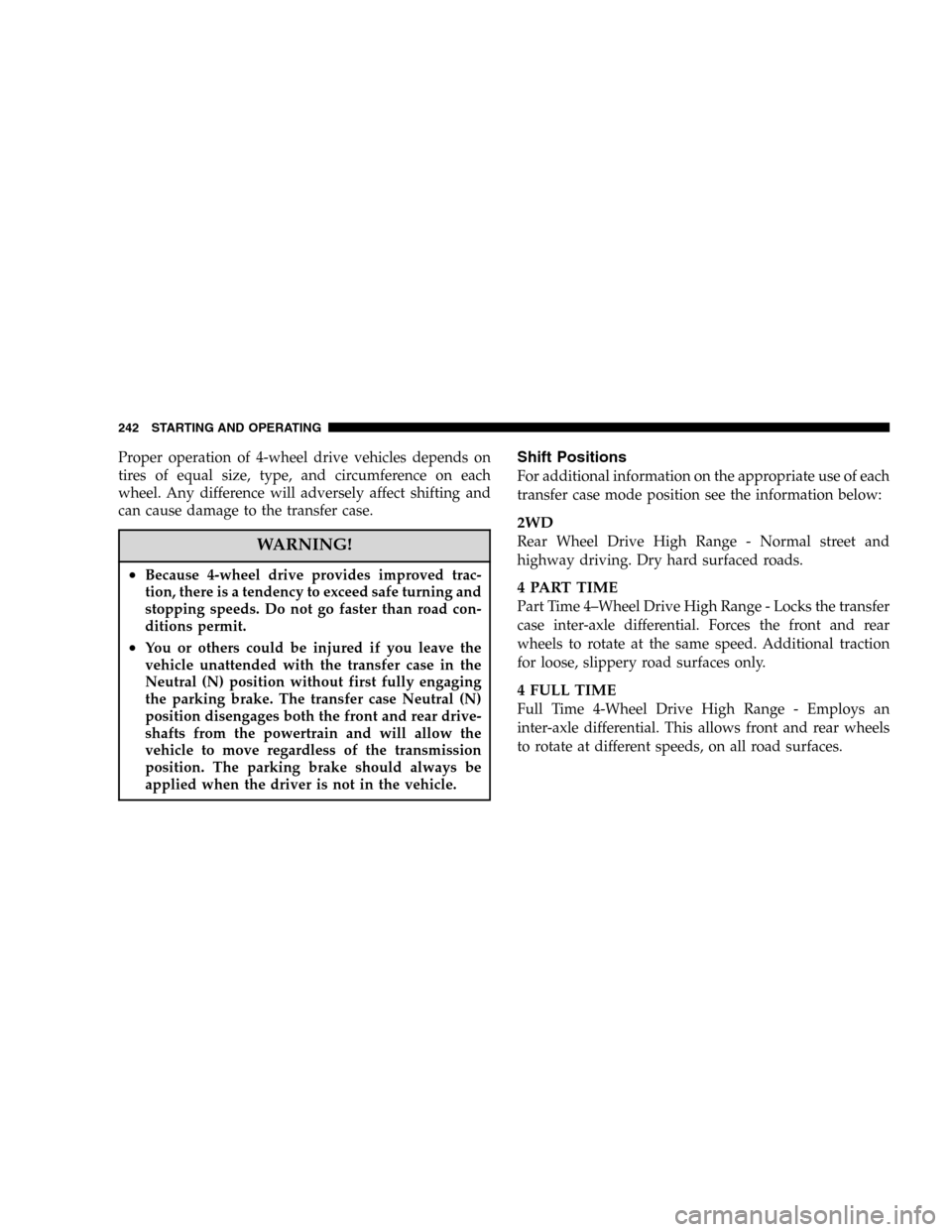
Proper operation of 4-wheel drive vehicles depends on
tires of equal size, type, and circumference on each
wheel. Any difference will adversely affect shifting and
can cause damage to the transfer case.
WARNING!
•Because 4-wheel drive provides improved trac-
tion, there is a tendency to exceed safe turning and
stopping speeds. Do not go faster than road con-
ditions permit.
•You or others could be injured if you leave the
vehicle unattended with the transfer case in the
Neutral (N) position without first fully engaging
the parking brake. The transfer case Neutral (N)
position disengages both the front and rear drive-
shafts from the powertrain and will allow the
vehicle to move regardless of the transmission
position. The parking brake should always be
applied when the driver is not in the vehicle.
Shift Positions
For additional information on the appropriate use of each
transfer case mode position see the information below:
2WD
Rear Wheel Drive High Range - Normal street and
highway driving. Dry hard surfaced roads.
4 PART TIME
Part Time 4–Wheel Drive High Range - Locks the transfer
case inter-axle differential. Forces the front and rear
wheels to rotate at the same speed. Additional traction
for loose, slippery road surfaces only.
4 FULL TIME
Full Time 4-Wheel Drive High Range - Employs an
inter-axle differential. This allows front and rear wheels
to rotate at different speeds, on all road surfaces.
242 STARTING AND OPERATING
Page 247 of 424
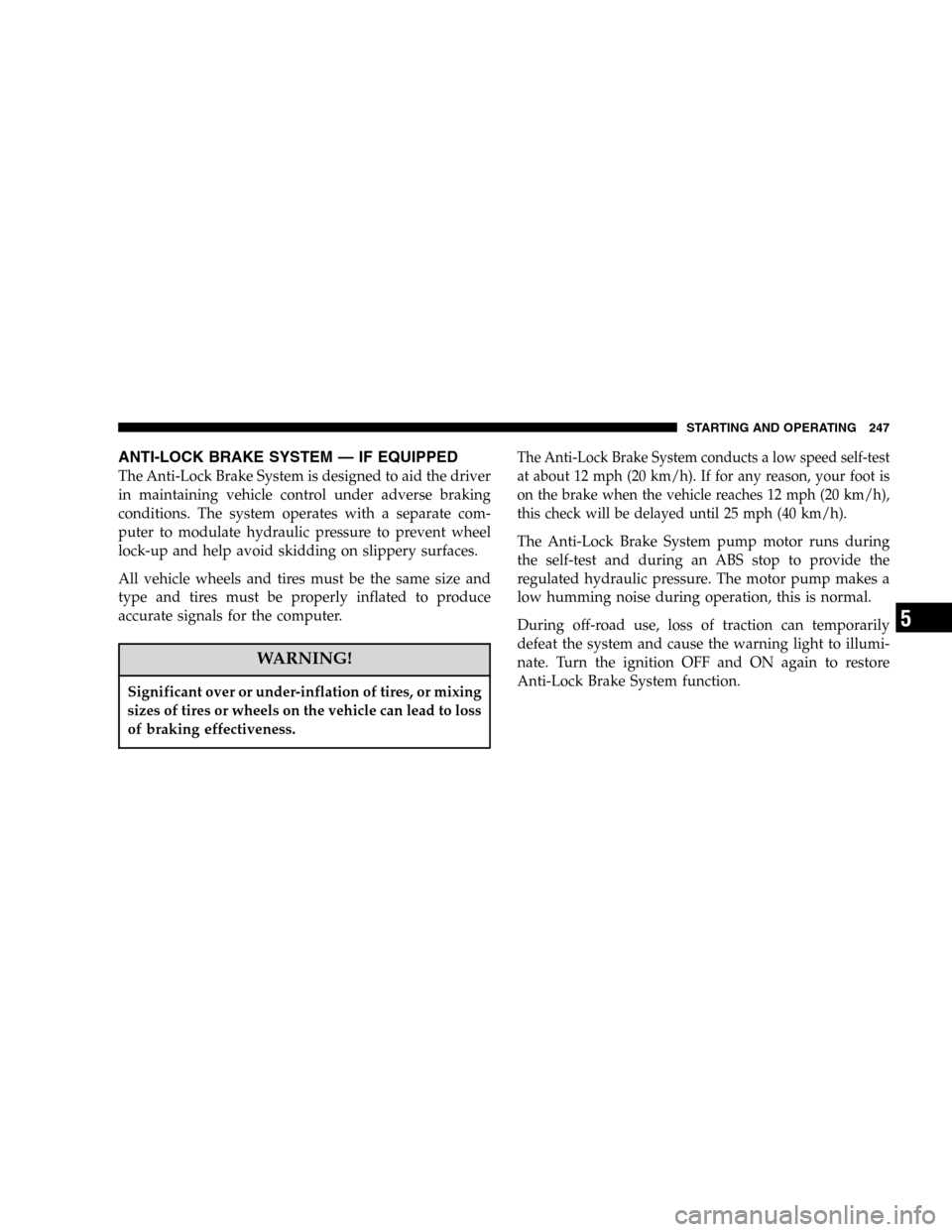
ANTI-LOCK BRAKE SYSTEM — IF EQUIPPED
The Anti-Lock Brake System is designed to aid the driver
in maintaining vehicle control under adverse braking
conditions. The system operates with a separate com-
puter to modulate hydraulic pressure to prevent wheel
lock-up and help avoid skidding on slippery surfaces.
All vehicle wheels and tires must be the same size and
type and tires must be properly inflated to produce
accurate signals for the computer.
WARNING!
Significant over or under-inflation of tires, or mixing
sizes of tires or wheels on the vehicle can lead to loss
of braking effectiveness.
The Anti-Lock Brake System conducts a low speed self-test
at about 12 mph (20 km/h). If for any reason, your foot is
on the brake when the vehicle reaches 12 mph (20 km/h),
this check will be delayed until 25 mph (40 km/h).
The Anti-Lock Brake System pump motor runs during
the self-test and during an ABS stop to provide the
regulated hydraulic pressure. The motor pump makes a
low humming noise during operation, this is normal.
During off-road use, loss of traction can temporarily
defeat the system and cause the warning light to illumi-
nate. Turn the ignition OFF and ON again to restore
Anti-Lock Brake System function.
STARTING AND OPERATING 247
5
Page 265 of 424
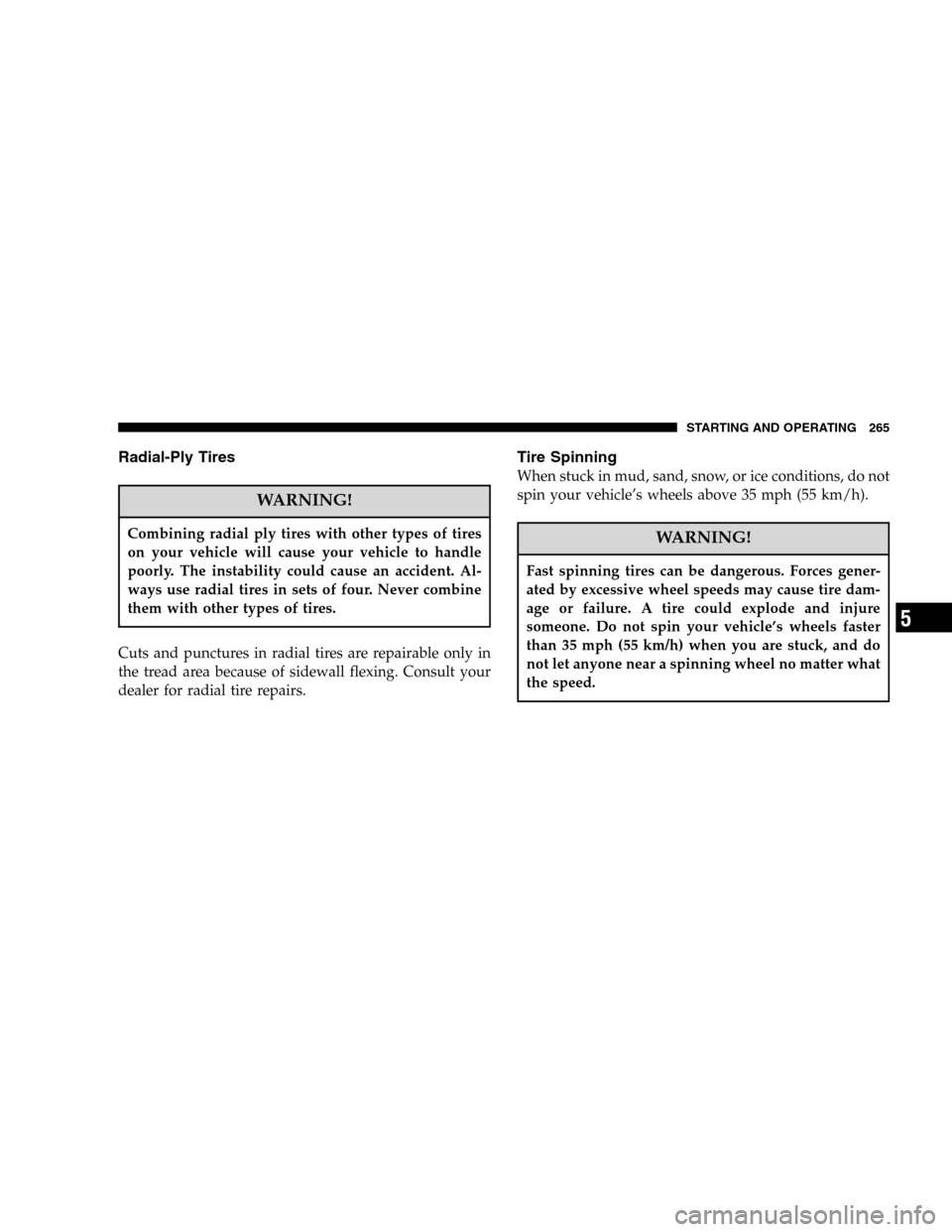
Radial-Ply Tires
WARNING!
Combining radial ply tires with other types of tires
on your vehicle will cause your vehicle to handle
poorly. The instability could cause an accident. Al-
ways use radial tires in sets of four. Never combine
them with other types of tires.
Cuts and punctures in radial tires are repairable only in
the tread area because of sidewall flexing. Consult your
dealer for radial tire repairs.
Tire Spinning
When stuck in mud, sand, snow, or ice conditions, do not
spin your vehicle’s wheels above 35 mph (55 km/h).
WARNING!
Fast spinning tires can be dangerous. Forces gener-
ated by excessive wheel speeds may cause tire dam-
age or failure. A tire could explode and injure
someone. Do not spin your vehicle’s wheels faster
than 35 mph (55 km/h) when you are stuck, and do
not let anyone near a spinning wheel no matter what
the speed.
STARTING AND OPERATING 265
5
Page 269 of 424
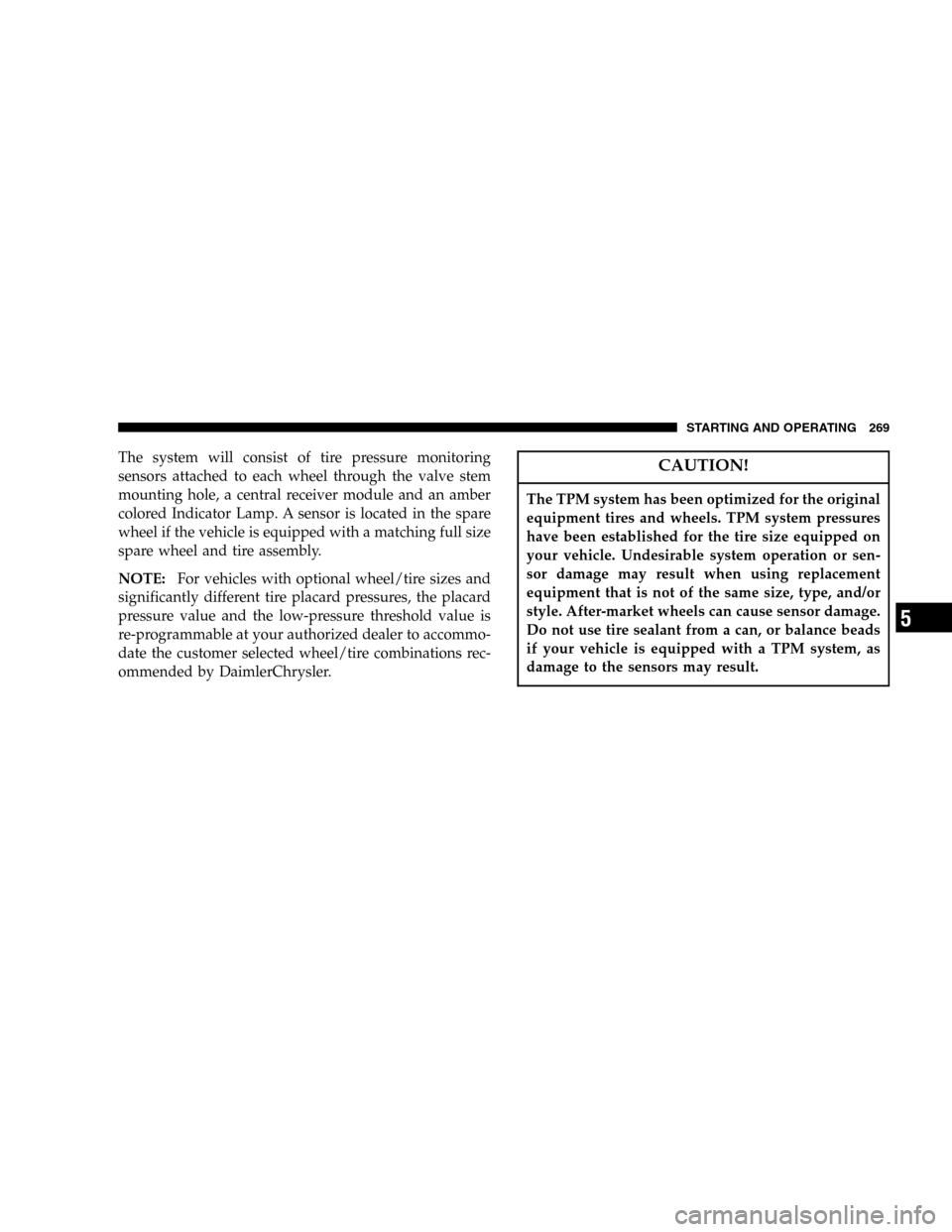
The system will consist of tire pressure monitoring
sensors attached to each wheel through the valve stem
mounting hole, a central receiver module and an amber
colored Indicator Lamp. A sensor is located in the spare
wheel if the vehicle is equipped with a matching full size
spare wheel and tire assembly.
NOTE:For vehicles with optional wheel/tire sizes and
significantly different tire placard pressures, the placard
pressure value and the low-pressure threshold value is
re-programmable at your authorized dealer to accommo-
date the customer selected wheel/tire combinations rec-
ommended by DaimlerChrysler.CAUTION!
The TPM system has been optimized for the original
equipment tires and wheels. TPM system pressures
have been established for the tire size equipped on
your vehicle. Undesirable system operation or sen-
sor damage may result when using replacement
equipment that is not of the same size, type, and/or
style. After-market wheels can cause sensor damage.
Do not use tire sealant from a can, or balance beads
if your vehicle is equipped with a TPM system, as
damage to the sensors may result.
STARTING AND OPERATING 269
5
Page 272 of 424
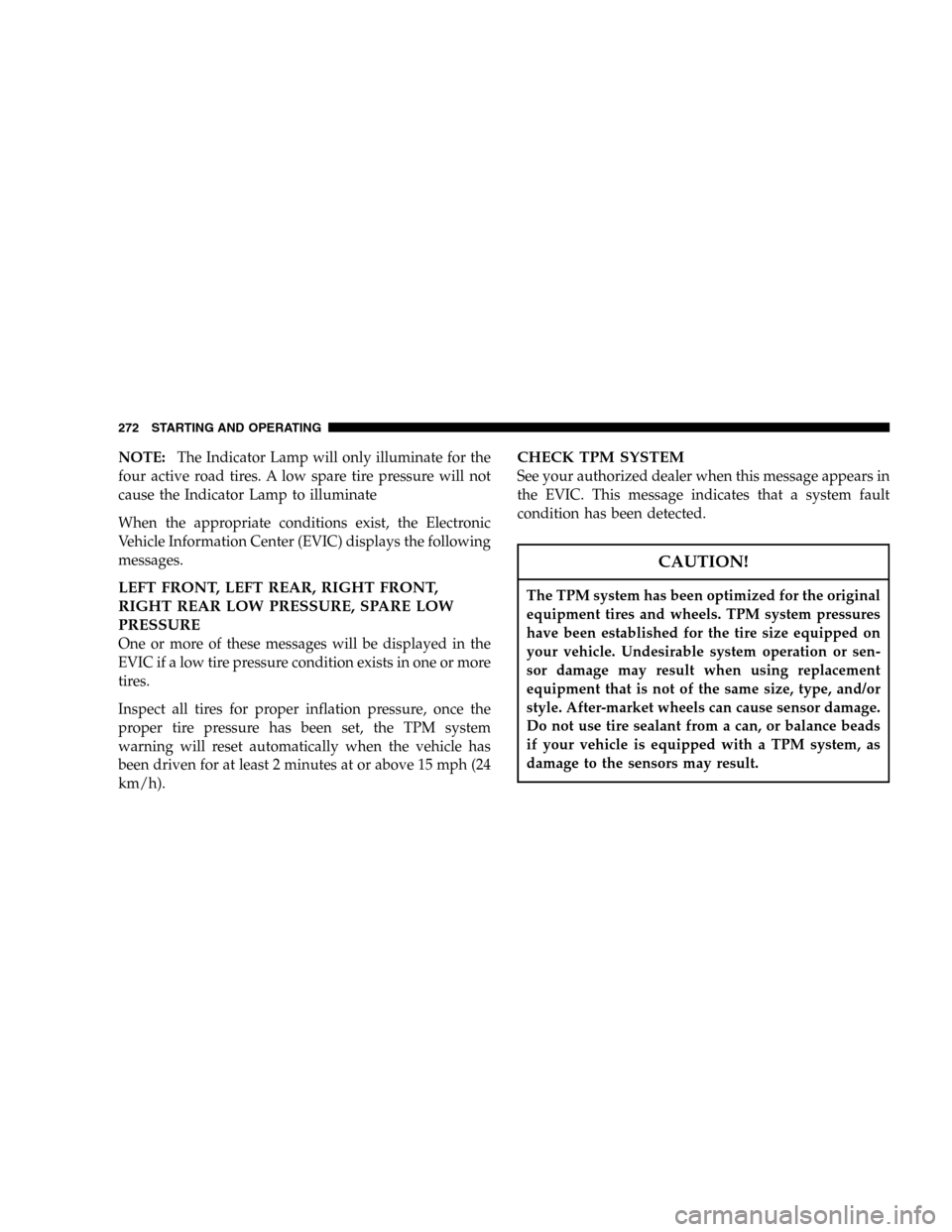
NOTE:The Indicator Lamp will only illuminate for the
four active road tires. A low spare tire pressure will not
cause the Indicator Lamp to illuminate
When the appropriate conditions exist, the Electronic
Vehicle Information Center (EVIC) displays the following
messages.
LEFT FRONT, LEFT REAR, RIGHT FRONT,
RIGHT REAR LOW PRESSURE, SPARE LOW
PRESSURE
One or more of these messages will be displayed in the
EVIC if a low tire pressure condition exists in one or more
tires.
Inspect all tires for proper inflation pressure, once the
proper tire pressure has been set, the TPM system
warning will reset automatically when the vehicle has
been driven for at least 2 minutes at or above 15 mph (24
km/h).
CHECK TPM SYSTEM
See your authorized dealer when this message appears in
the EVIC. This message indicates that a system fault
condition has been detected.
CAUTION!
The TPM system has been optimized for the original
equipment tires and wheels. TPM system pressures
have been established for the tire size equipped on
your vehicle. Undesirable system operation or sen-
sor damage may result when using replacement
equipment that is not of the same size, type, and/or
style. After-market wheels can cause sensor damage.
Do not use tire sealant from a can, or balance beads
if your vehicle is equipped with a TPM system, as
damage to the sensors may result.
272 STARTING AND OPERATING
Page 275 of 424
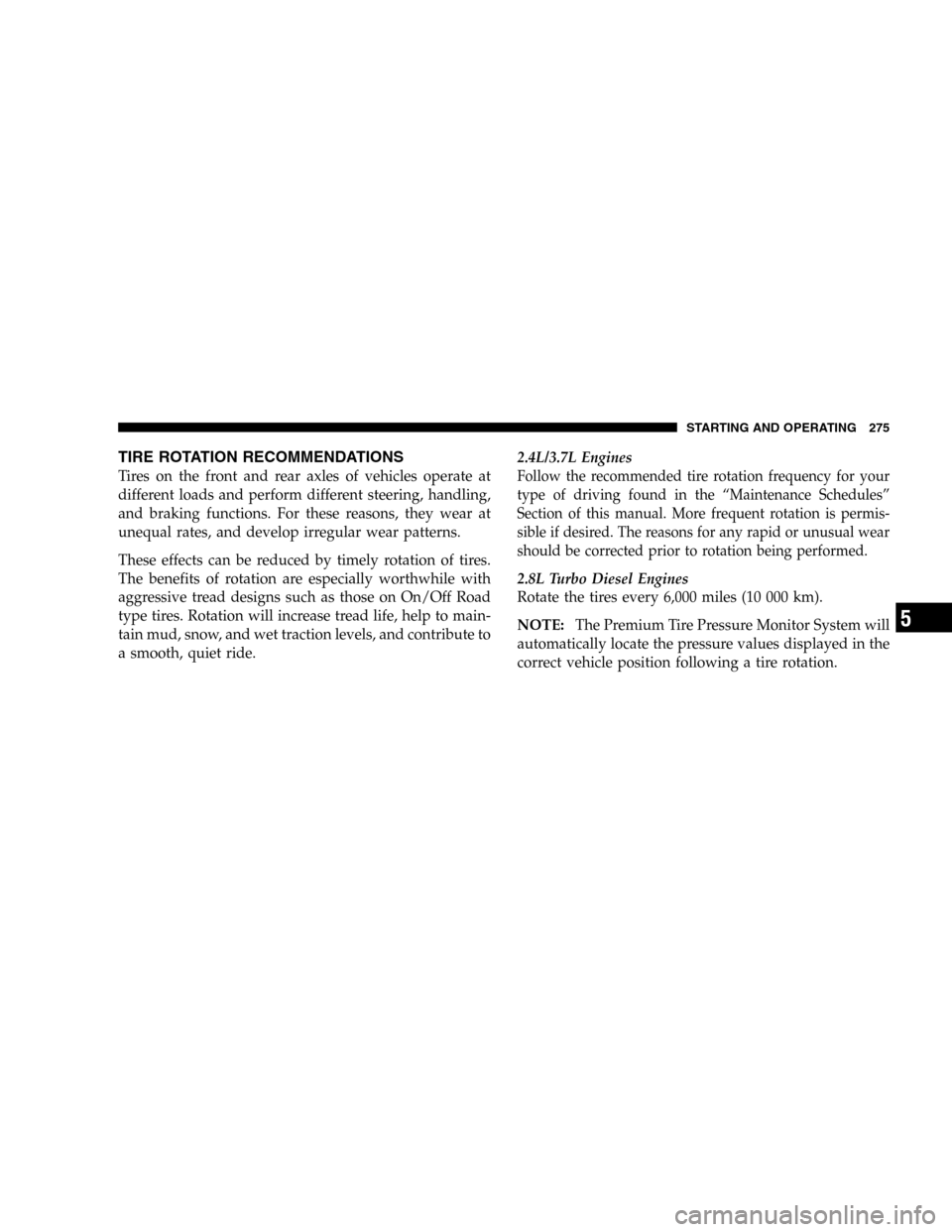
TIRE ROTATION RECOMMENDATIONS
Tires on the front and rear axles of vehicles operate at
different loads and perform different steering, handling,
and braking functions. For these reasons, they wear at
unequal rates, and develop irregular wear patterns.
These effects can be reduced by timely rotation of tires.
The benefits of rotation are especially worthwhile with
aggressive tread designs such as those on On/Off Road
type tires. Rotation will increase tread life, help to main-
tain mud, snow, and wet traction levels, and contribute to
a smooth, quiet ride.2.4L/3.7L EnginesFollow the recommended tire rotation frequency for your
type of driving found in the “Maintenance Schedules”
Section of this manual. More frequent rotation is permis-
sible if desired. The reasons for any rapid or unusual wear
should be corrected prior to rotation being performed.
2.8L Turbo Diesel Engines
Rotate the tires every 6,000 miles (10 000 km).
NOTE:The Premium Tire Pressure Monitor System will
automatically locate the pressure values displayed in the
correct vehicle position following a tire rotation.
STARTING AND OPERATING 275
5
Page 295 of 424
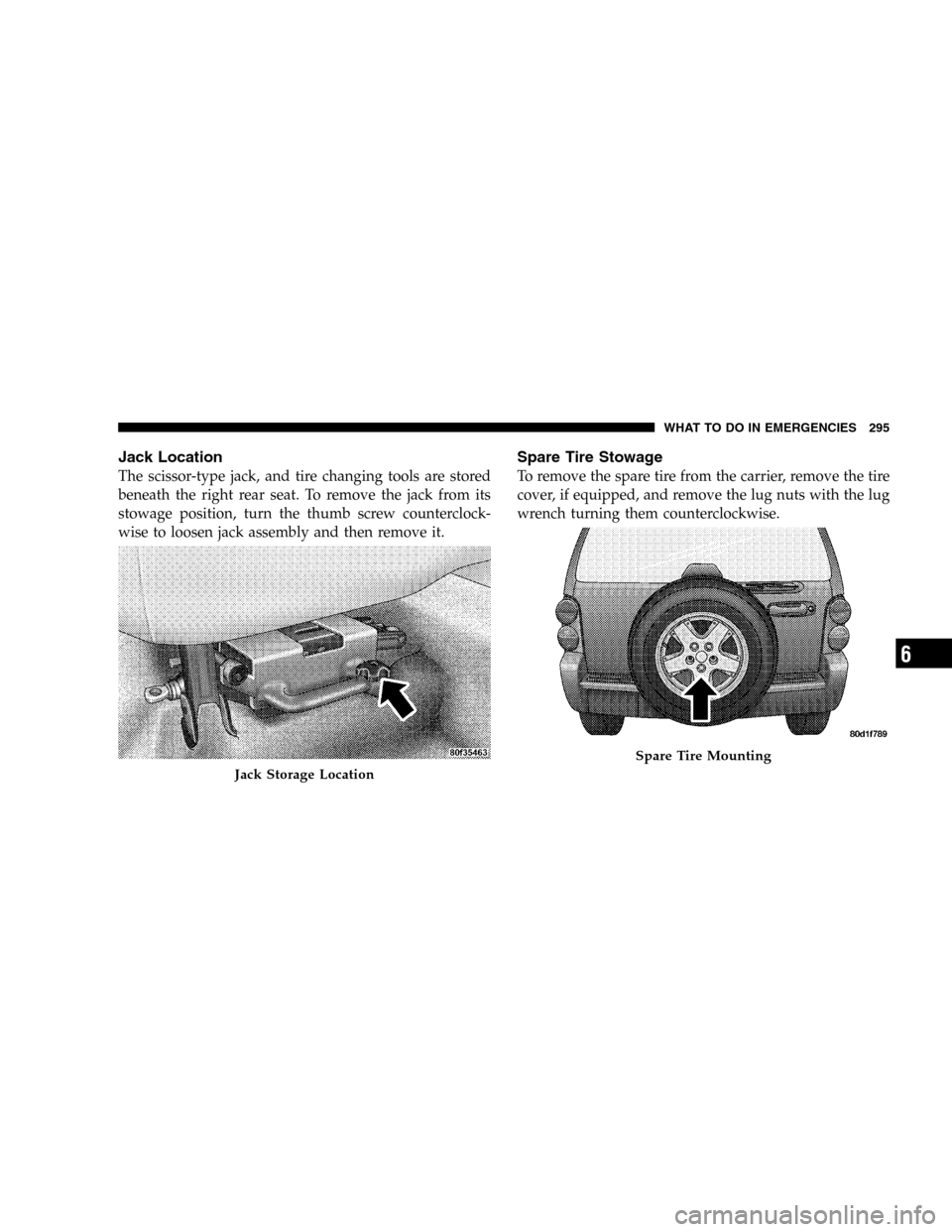
Jack Location
The scissor-type jack, and tire changing tools are stored
beneath the right rear seat. To remove the jack from its
stowage position, turn the thumb screw counterclock-
wise to loosen jack assembly and then remove it.
Spare Tire Stowage
To remove the spare tire from the carrier, remove the tire
cover, if equipped, and remove the lug nuts with the lug
wrench turning them counterclockwise.
Jack Storage Location
Spare Tire Mounting
WHAT TO DO IN EMERGENCIES 295
6
Page 400 of 424
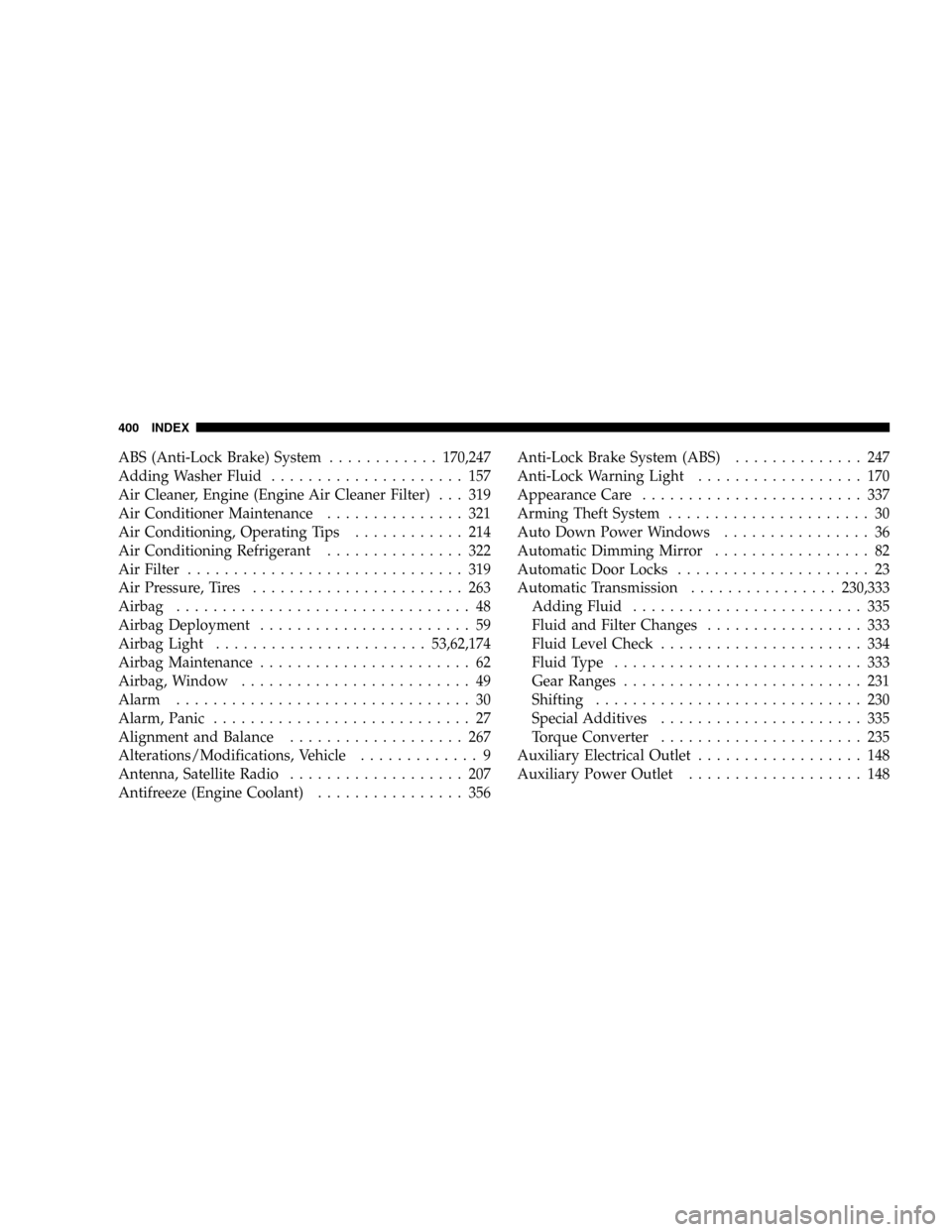
ABS (Anti-Lock Brake) System............170,247
Adding Washer Fluid..................... 157
Air Cleaner, Engine (Engine Air Cleaner Filter) . . . 319
Air Conditioner Maintenance............... 321
Air Conditioning, Operating Tips............ 214
Air Conditioning Refrigerant............... 322
Air Filter.............................. 319
Air Pressure, Tires....................... 263
Airbag................................ 48
Airbag Deployment....................... 59
Airbag Light.......................53,62,174
Airbag Maintenance....................... 62
Airbag, Window......................... 49
Alarm................................ 30
Alarm, Panic............................ 27
Alignment and Balance................... 267
Alterations/Modifications, Vehicle............. 9
Antenna, Satellite Radio................... 207
Antifreeze (Engine Coolant)................ 356Anti-Lock Brake System (ABS).............. 247
Anti-Lock Warning Light.................. 170
Appearance Care........................ 337
Arming Theft System...................... 30
Auto Down Power Windows................ 36
Automatic Dimming Mirror................. 82
Automatic Door Locks..................... 23
Automatic Transmission................230,333
Adding Fluid......................... 335
Fluid and Filter Changes................. 333
Fluid Level Check...................... 334
Fluid Type........................... 333
Gear Ranges.......................... 231
Shifting............................. 230
Special Additives...................... 335
Torque Converter...................... 235
Auxiliary Electrical Outlet.................. 148
Auxiliary Power Outlet................... 148
400 INDEX